This page was updated on 8/8/2025 with one more ancient bell on which the partials were identified from nodal patterns. This process has now been carried out on 15 long-waisted bells.
For an explanation of the term ‘long waisted’ see the pictures of bells below. In the UK, bells with this shape are typically from the 12th or 13th centuries or earlier. Their partials have a different relationship to those of bells with normal, more recent shape. Prompted by a visit to St Botolph’s, Hardham, Sussex where the older bell may be pre-conquest, I have investigated the partials of a number of long-waisted bells. The insights gained may help others analysing recordings of such bells.
Since beginning this work I have devised a technique documented here for identifying partials in bells, by determining the nodal patterns round the rim and up the waist. The technique has been applied to fourteen of the bells listed here and gives confidence that the partial identification for these bells is correct. In a number of photos below, the markings for partial identification can be seen.
Here are recordings of some of the bells investigated – details are below:
- Dulas (date around 1225)
- Heacham (date around 1150)
- Sneaton (date around 1300)
- Werrington (date around 1275)
The long-waisted bells are as follows:
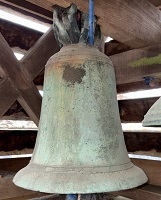 | Appleshaw, Hampshire, date around 1200, diameter 0.36m. Photo by Martin Barnes, recording by me. | 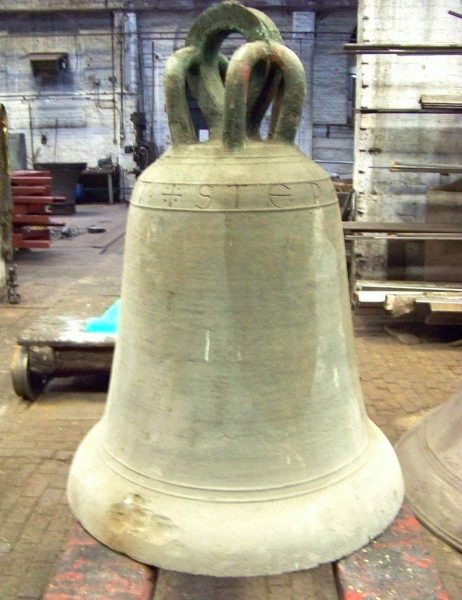 | Auckland Castle, dated 1180, diameter 0.71m. Photo courtesy of Taylor’s Bellfoundry. Recording provided by George Dawson. |
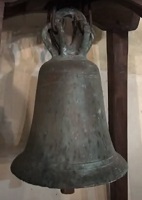 | Avington, Berkshire, date around 1220, diameter 0.48m. Photo and recording from youtube video by Jake Reid. | 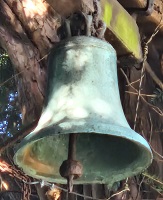 | Barfrestone, Kent, date around 1250, diameter 0.38m. Photo and recording by me. |
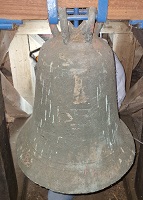 | Bramshaw, Hampshire, date around 1199, diameter 0.50m. Photo and recording by me. | 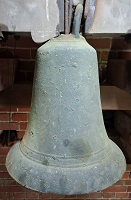 | Chilworth, Hampshire, no.1, date around 1100, diameter 0.42m. Photo by Kye Leaver, recording by me. |
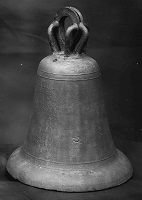 | Chilworth, Hampshire, no.2, date around 1120, diameter 0.44m. Photo by Taylors (1924), recording by me. |  | Coombes, Sussex, date around 1150, diameter 0.40m. Section from Elphick page 6. Recording by me. |
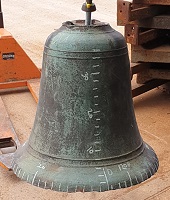 | Dulas, Herefordshire (now at Matthew Higby’s works), date around 1225, diameter 0.43m. Photo and recording by me. | 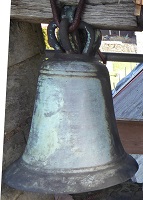 | Gwernesney, Monmouthshire, north turret, date around 1200, diameter 0.438m. Photo and recording by Chris Pickford. |
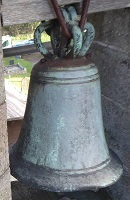 | Gwernesney, Monmouthshire, south turret, date around 1200, diameter 0.445m. Photo and recording by Chris Pickford. |  | Hardham, dated by George Elphick to 1050, diameter 0.41m. Section from Elphick page 6. Recording by me. |
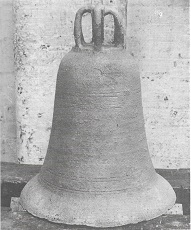 | Harescombe, Gloucestershire, dated circa 1199, weight 50kg, diameter 0.45m. Photograph taken from page 359 of Bliss and Sharpe’s Church Bells of Gloucestershire. Youtube recording by Ringer Mikey. | 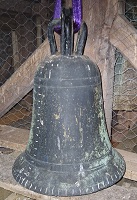 | Heacham, Norfolk, date circa 1150, diameter 0.51m. Photograph and recording by me. |
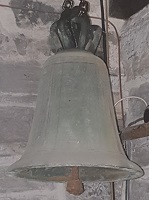 | Hognaston, Derbyshire, date unknown, diameter 0.38m. Photograph and recording by me. | 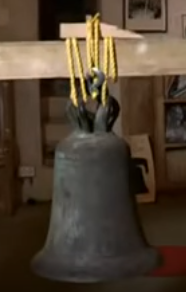 | Leighton Buzzard sanctus, date around 1250, weight around 80kg, diameter 0.48m. Youtube recording by George Vant. |
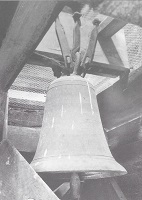 | Llanelieu, Powys, north side, date around 1180, diameter 0.44m. Photograph Chris Dalton on page xvi of John Eisel’s Church Bells of Breconshire, recording by me. | 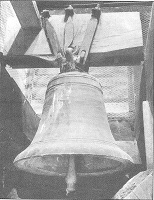 | Llanelieu, Powys, south side, date around 1300, diameter 0.43m. Photograph Chris Dalton on page 60 of John Eisel’s Church Bells of Breconshire, recording by me. |
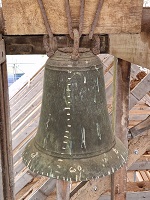 | Llangua, Montgomeryshire, date around 1200, diameter 0.41m. Photograph and recording by me. | 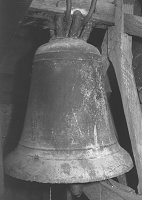 | Mattingley, Hampshire, date around 1180, diameter 0.41m. Photograph by David Holmes, recording by Tim Jackson. |
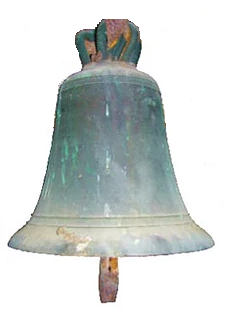 | Myndtown, Shropshire, date around 1150, diameter 0.37m. Recording provided by George Dawson. | 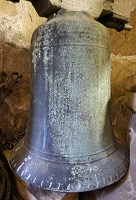 | Pipe Ridware, Staffordshire, date around 1225, diameter 0.50m. Photograph and recording by me. |
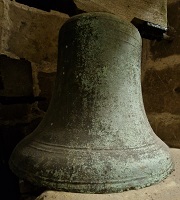 | Pipe Ridware, Staffordshire, date around 1285, diameter 0.53m. Photograph and recording by me. | 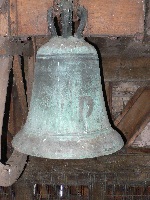 | Ribbesford, Worcestershire, date around 1150, diameter circa 0.5m (the bell is not circular). Recording and picture from Chris Pickford. The picture is upside down, the bell was ‘up’ when it was taken. |
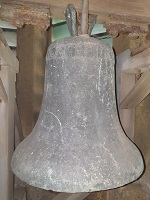 | Sneaton, North Yorkshire, date around 1300, diameter 0.40m. Photograph and recording by me. | 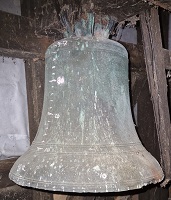 | Up Waltham, Sussex, date around 1275, diameter 0.47m. Photo and recording by me. |
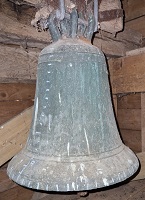 | Warminghurst, Sussex, date around 1200, diameter 0.46m. Photo and recording by me. | 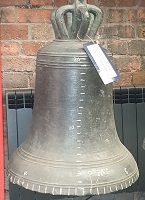 | Werrington, Cambridgeshire (now in Taylor’s museum), date around 1275, diameter 0.56m. Photograph and recording by me. |
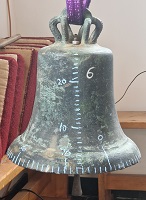 | Whaley Hall, Derbyshire (was the Saffron Walden sanctus), date around 1250, diameter 0.33m. Photograph and recording by me. |
The partial frequencies of these bells in cycles per second are as follows:
| Bell | Hum | cents | Prime | cents | Tierce | cents | Quint | cents | Nom’l | S’quint | cents | O’nom. | cents |
|---|---|---|---|---|---|---|---|---|---|---|---|---|---|
| Appleshaw + | 476.2 | -2875 | 993.3 | -1602 | 1375.4 | -1039 | 1087.3 | -1446 | 2506.5 | 3637.3 | 645 | 5258.8 | 1283 |
| Auckland | 310.5 | -2721 | 670.0 | -1390 | 835.0 | -1008 | 985.5 | -722 | 1495.0 | 2277.0 | 728 | 3156.0 | 1294 |
| Avington | 387.0 | -2824 | 864.5 | -1432 | 998.5 | -1183 | 1977.0 | 2986.0 | 714 | 4122.0 | 1272 | ||
| Barfrestone | 511.5 | -2452 | 733.0 | -1829 | 1062.0 | -1187 | 1344.5 | -779 | 2108.5 | 3006.5 | 614 | 4041.0 | 1126 |
| Bramshaw + | 466.6 | -2684 | 930.7 | -1489 | 1237.5 | -995 | 1438.4 | -735 | 2199.1 | 3331.6 | 719 | 4591.6 | 1275 |
| Chilworth 1+ | 547.9 | -2571 | 916.5 | -1680 | 1412.9 | -931 | 1489.4 | -839 | 2418.4 | 3582.0 | 680 | 4874.2 | 1213 |
| Chilworth 2+ | 427.6 | -2753 | 831.5 | -1602 | 1206.8 | -957 | 1923.6 | -150 | 2097.2 | 3316.9 | 794 | 4529.3 | 1333 |
| Coombes | 496.0 | -2684 | 952.5 | -1555 | 1193.5 | -1164 | 1373.0 | -922 | 2338.0 | 3471.0 | 684 | 4733.0 | 1221 |
| Dulas + | 443.2 | -2778 | 943.2 | -1470 | 1281.1 | -940 | 1890.9 | -266 | 2204.9 | 3303.4 | 700 | 4515.2 | 1241 |
| Gwernesney (north) | 393.0 | -2739 | 856.0 | -1391 | 1122.5 | -922 | 1911.5 | 2897.0 | 720 | 4009.5 | 1283 | ||
| Gwernesney (south) | 410.0 | -2677 | 912.5 | -1292 | 1101.5 | -967 | 1925.0 | 2866.4 | 689 | 3930.0 | 1236 | ||
| Hardham | 496.5 | -2765 | 914.5 | -1708 | 1408.5 | -960 | 2169.0 | -213 | 2452.5 | 3697.5 | 711 | 5075.0 | 1259 |
| Harescombe | 420.0 | -2727 | 757.5 | -1706 | 1174.0 | -947 | 2029.5 | 2985.0 | 668 | 4041.5 | 1193 | ||
| Heacham + | 343.2 | -2665 | 732.0 | -1354 | 921.8 | -954 | 989.2 | -832 | 1599.8 | 2395.2 | 699 | 3307.8 | 1258 |
| Hognaston + | 453.5 | -2738 | 962.5 | -1435 | 1304.1 | -910 | 1033.3 | -1313 | 2205.3 | 3323.1 | 710 | 4503.4 | 1236 |
| Leighton Buzzard | 460.5 | -2653 | 898.5 | -1496 | 1224.0 | -961 | 2132.0 | 3191.5 | 698 | 4345.5 | 1233 | ||
| Llanelieu (north) | 432.5 | -2680 | 853.5 | -1503 | 1155.5 | -979 | 2034.0 | 3064.5 | 710 | 4223.0 | 1265 | ||
| Llanelieu (south) | 400.5 | -2647 | 884.5 | -1275 | 1063.0 | -957 | 1847.5 | 2779.5 | 707 | 3853.0 | 1273 | ||
| Llangua + | 424.7 | -2911 | 831.2 | -1748 | 1214.0 | -1092 | 971.5 | -1478 | 2281.6 | 3312.1 | 645 | 4486.9 | 1171 |
| Mattingley | 494.0 | -2765 | 978.0 | -1582 | 1414.0 | -944 | 2439.5 | 3680.0 | 794 | 5240.0 | 1324 | ||
| Myndtown | 500.0 | -2717 | 1082.0 | -1381 | 1395.0 | -941 | 1714.5 | -584 | 2402.5 | 3612.5 | 706 | 4966.0 | 1257 |
| Pipe Ridware 1225 + | 430.9 | -2754 | 788.3 | -1708 | 1222.0 | -949 | 1038.1 | -1231 | 2114.0 | 3256.2 | 748 | 4421.0 | 1277 |
| Pipe Ridware 1285 +* | 436.5 | -2311 | 699.5 | -1494 | 980.7 | -909 | 1222.1 | -528 | 1658.0 | 2475.8 | 694 | 3404.4 | 1246 |
| Ribbesford | 353.0 | -2746 | 789.0 | -1354 | 897.5 | -1131 | 1027.5 | -896 | 1724.5 | 2608.0 | 716 | 3795.0 | 1366 |
| Sneaton + | 471.5 | -2449 | 751.0 | -1643 | 1050.0 | -1063 | 1299.5 | -694 | 1940.0 | 2853.5 | 668 | 3943.5 | 1228 |
| Up Waltham +* | 421.4 | -2327 | 746.5 | -1337 | 957.6 | -906 | 1172.1 | -556 | 1615.7 | 2424.0 | 702 | 3347.1 | 1261 |
| Warminghurst + | 402.2 | -2743 | 837.7 | -1473 | 1130.6 | -954 | 957.1 | -1242 | 1961.6 | 3067.5 | 774 | 4190.9 | 1314 |
| Werrington +* | 424.0 | -2371 | 657.8 | -1611 | 977.5 | -925 | 1668.2 | 2496.0 | 698 | 3423.1 | 1244 | ||
| Whaley Hall +* | 607.0 | -2362 | 1042.5 | -1426 | 1391.5 | -926 | 1648.0 | -633 | 2375.5 | 3577.0 | 709 | 4929.0 | 1264 |
The intervals in cents of all the partials in this table are given relative to the nominal of the bell.
The partials in bells marked + were identified by their nodal patterns.
In the bells marked *, although the bell appears long-waisted, the detailed profile of the bell means the partial intervals are not very different from those of a bell with modern shape. These bells can be considered to be transitional in shape between long-waisted and modern.
The recording for Ribbesford is poor and the identification of the partials a little uncertain. Some partial frequencies for the Harescombe bell are given on page 360 of Church Bells of Gloucestershire but I do not think they are correct.
A bell with a modern profile would have hum, prime and tierce intervals to the nominal broadly as hum: -2400 cents, prime: -1200 cents and tierce: -900 cents. So the effect of the long waist is to significantly lower these partials relative to the nominal. The superquint and octave nominal, on the other hand, are not exceptional. The interval of the superquint and octave nominal relative to the nominal is dominated by the shape and thickness of the rim or soundbow. As these bells have a thickened soundbow, the upper partials have the normal relationship with the nominal. This relationship was used when analysing these bells to confirm that the nominal was identified correctly. In some of the bells (Appleshaw, Hognaston, Llangua, Pipe Ridware 1225 and Warminghurst) the quint is lower in frequency than the tierce.
As a practical guide to the difficulty in assigning names to the partials of bells like these, here are spectra of two bells:
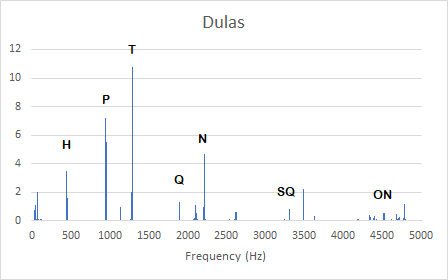
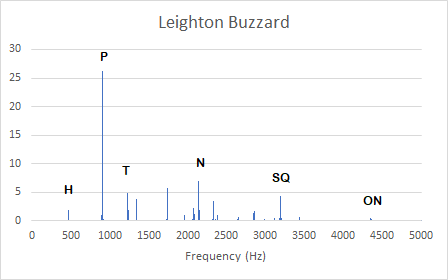
The partials are named in each case with their initial letter. The partials of the Dulas bell were determined by their nodal patterns, so there is a good degree of confidence they are correct. There are stronger partials just above the superquint and octave nominal, but the partials selected for these are the lowest frequency with the correct nodal patterns around the rim and up the waist.
In the spectrum of the Leighton Buzzard bell, it would be tempting to assign the second partial above the tierce as the nominal. However this gives no reasonable candidates for the superquint, octave nominal and higher frequency rim partials. With the nominal chosen, the intervals of nominal, superquint and octave nominal is conventional which is plausible given the well-developed soundbows in these bells. The wide intervals from hum, prime and tierce to the nominal match the Dulas intervals, where the partials have been identified by their nodal patterns. There are four partials between the tierce and the partial selected as nominal. In a bell of normal profile, three of these partials would be higher in frequency and appear between nominal and superquint. In these bells, it is plausible that the long waist has lowered the frequency of the partials.
Because these bells are small with high frequency partials, the pitch is set by the hum, not the nominal, so it is not possible to use an estimation of pitch (as was done for tubular bells) to identify the nominal.
Assigning a partial as the quint in any of these bells is speculative. Even when the nodal patterns are known it is sometimes not obvious which partial is the quint.
It was illuminating to compare the partial frequencies of these bells. Bells like these have been difficult to analyse, but once the common pattern of the lower partials became clear, and thirteen of the bells had the nodal patterns of their partials established, it became much easier to assign the partials for each.
Acknowledgements
George Dawson and Chris Pickford helped with this investigation in a number of ways: by providing a comprehensive list of old bells in the UK, by providing recordings and photographs, and in creating opportunities for me to experiment on long-waisted bells. Matthew Higby and Ben Kipling helped with access to the Dulas bell, and Father Jamie MacLeod with access to the Whaley Hall bell. Tim Jackson organised visits to a number of bells in Hampshire.
References
Bliss M & Sharpe F, Church Bells of Gloucestershire, Alan Sutton 1986
Eisel J, Church Bells of Breconshire, Logaston Press, 2002
Elphick GP, Sussex Bells and Belfries, Phillimore, 1970